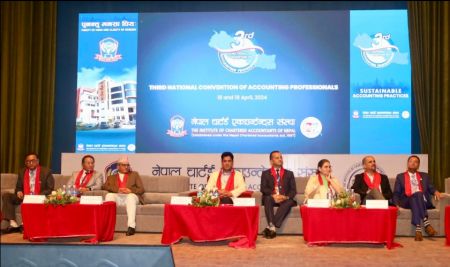.jpg)
The US Agency for International Development (USAID) launched a USD 4 million business literacy project in Nepal on July 18. The project is a part of the US Government’s USD 66 million five-year ‘Feed the Future Initiative in Nepal’ that aims to raise incomes and improve livelihoods of vulnerable households. The newly launched project is expected to build literacy, numeracy, entrepreneurship, financial management and life skills of 48,000 Nepalis in the west, mid-west and far-west regions.
“In addition to building literacy skills, the project will enable access to income generation opportunities in agriculture and to initiate small-scale enterprises. These skills and access are fundamental to helping people move out of poverty,” explained Beth Beth Dunford, mission director of USAID Nepal.
USAID’s five-year strategy in Nepal aims to foster a more democratic, prosperous and resilient Nepal. “Our work in Nepal is founded on the premise that if selected institutions become more effective at delivering services, more adept at engaging citizens—and more responsive to their needs—and if communities’ economic, environmental and human capacity are strengthened, then Nepal will become more democratic, prosperous, and resilient,” Dunford said.
Implementation
The new three-year project will be implemented by Nepali NGOs DEPROSC-Nepal and Samjhauta Nepal and will work closely with the Non-Formal Education Centre, District Education Offices and Village Development Committees. The new project also coordinates with other ongoing USAID projects such as the Knowledge-based Integrated Sustainable Agriculture and Nutrition (KISAN) Project, the Suaahara Project, Health for Life Project, and the Sajhedari Project.
The project will target 48,000 beneficiaries in USAID’s 20 focus districts in the west, mid-west, and far-west regions. According to USAID,in the first phase the project will operate in 10 districts of the mid-west— Banke, Bardia, Dailekh, Dang, Jajarkot, Pyuthan, Rolpa, Rukum, Salyan and Surkhet. In the second phase, it will operate in six districts of the far-west—Achham, Baitadi, Dadeldhura, Doti, Kailali and Kanchanpur – and four districts of the western region—Arghakhachi, Gulmi, Kapilvastu, and Palpa.
Linkage with other projects
The Business Literacy project builds upon previous USAID efforts and expands on trainings that empower women, youth and marginalized communities, the USAID said in a press release. It claims that the entrepreneurial trainings conducted from 2008 to 2012 have created a livelihood foundation for more than 32,000 youth, women, and marginalized people in Nepal’s mid-western region. Dunford stresses, “We know from experience that linking health, nutrition and entrepreneurial literacy activities to agriculture greatly increases the chances of lifting people out of poverty.”
Speaking at the project launching programme he added, “The Business Literacy project will complement the Nepali government’s priority of eradicating illiteracy from the country by 2015 and support the government efforts to end extreme poverty.”
.jpg)
Project Activities
Develop business literacy training materials
• Literacy and Numeracy: 16 weeks focused on basic reading, writing, and math skills.
• Nutrition Education: Four weeks focused on basic nutrition, hygiene, maternal and child health care, sanitation and food safety education.
• Life Skills: Eight weeks focused on HIV/AIDS, disaster risk reduction, floods, earthquakes or fires, and human trafficking.
• Entrepreneurial Skills: 16 weeks focused on agriculture and livestock.
• Access to Finance: Four weeks focused on common loan terms and interest rates.
• Module Guide Book Set: One set for each module to facilitate community trainers to run the classes.
• Develop manual guide to master trainers for conducting training of trainers.
Develop trainers
• Select and build capacity of 150 master trainers and 2,000 community trainers.
Deliver business literacy training
• Organize 48 weeks of training for 48,000 beneficiaries.
Expected Outputs
• Improved literacy and numeracy
• Improved life skills
• Improved awareness of nutrition and child health practices
• Increased entrepreneurial skills
• Improved access to financial services
• Increased access to productive economic resources





















